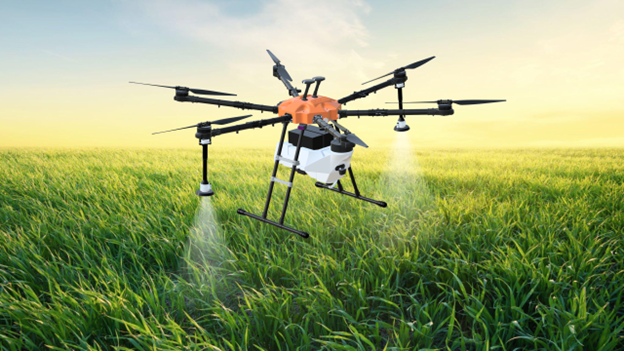How Drones Are Revolutionizing Agriculture
Agriculture is the backbone of India’s economy, employing nearly 60% of the population. However, farmers continue to face significant challenges such as labor shortages, inefficient resource management, and unpredictable weather patterns. These factors often lead to lower productivity and increased costs, making farming a difficult and uncertain profession. In recent years, drone technology has emerged as a transformative tool, offering farmers innovative solutions to improve efficiency, reduce costs, and enhance yield quality. With strong government support, promising research, and real-world applications, drones are reshaping the future of Indian agriculture.
For the first time in Kerala, drones were successfully used for paddy seed broadcasting in Kuttanad, a region known for its labor-intensive farming. This groundbreaking experiment was conducted by the Kerala Agricultural University’s Krishi Vigyan Kendra (KVK). Traditionally, paddy sowing in this area requires extensive manual labor, often taking an entire day to complete an acre. However, with the use of drones, the same task was accomplished in just 20 minutes. This innovative approach not only helps address the issue of labor shortages but also ensures uniform seed distribution, leading to better crop growth and higher yields. The success of this experiment paves the way for wider adoption of drone technology in rice cultivation across India.
In
addition to aiding in sowing, drones are revolutionizing the way pesticides and
fertilizers are applied to crops. Research conducted by the University of
Agricultural Sciences (UAS) in Bengaluru has demonstrated the benefits of using
drones for precision pesticide spraying. Their study found that drone-assisted
spraying reduces chemical usage by at least 15% while improving application
efficiency by nearly 23%. The ability of drones to deliver pesticides precisely
to targeted areas ensures that crops receive adequate protection while
minimizing excessive chemical exposure. This not only lowers costs for farmers
but also reduces soil and water contamination, leading to more sustainable
farming practices. As environmental concerns continue to grow, precision
agriculture using drones could significantly contribute to safer and
eco-friendly farming methods.
Recognizing
the immense potential of drones in agriculture, the Indian government has been
actively promoting their adoption through various initiatives. One of the most
ambitious programs is the ‘Kisan Drones’ initiative, aimed at equipping farmers
with drone technology for essential farming operations. The Andhra Pradesh
government has taken a significant step by announcing the launch of 875 drone
service centers across the state. These centers will not only provide farmers
access to drone services but also offer training on operating drones for tasks
such as spraying fertilizers and pesticides. To encourage widespread adoption,
the government is offering a 40% subsidy to farmers investing in drone
technology. With such strong backing, the use of drones in Indian agriculture
is expected to expand rapidly in the coming years.
Challenges
& Opportunities in India
Despite
the many benefits drones bring to agriculture, several challenges hinder their
widespread adoption. One of the primary obstacles is the high initial
investment required to purchase drones and train farmers in their operation.
Small-scale farmers, who form the majority of India’s agricultural workforce,
often find it difficult to afford these costs. Additionally, regulatory
approvals pose another hurdle, as farmers must comply with guidelines set by
the Directorate General of Civil Aviation (DGCA) for drone usage in
agriculture. These regulations are necessary to ensure safe and responsible
drone operations but can sometimes be cumbersome for farmers unfamiliar with
the process. Another challenge is the lack of awareness about drone technology
among rural farmers. Many farmers in remote areas are still unfamiliar with how
drones work and the advantages they offer. However, with increasing government
support, awareness campaigns, and training programs, drones are gradually
becoming more accessible. The availability of subsidies, financial aid, and
private-sector involvement will further help bridge the gap, making drones a
viable option for more farmers across the country.
Conclusion
From
seed sowing to pesticide spraying, drones are proving to be a revolutionary
tool in Indian farming. By reducing labor dependency, cutting costs, and
improving efficiency, drones are helping farmers overcome longstanding
agricultural challenges. With government initiatives like the ‘Kisan Drones’
program and ongoing technological advancements, drones are set to play a
crucial role in shaping the future of Indian agriculture. As more farmers adopt
this innovative technology, India’s farming sector will move towards greater
sustainability, efficiency, and productivity, ultimately contributing to the
country’s overall agricultural growth.
.png)






Leave a Comment
Your email address will not be published. Required fields are marked *